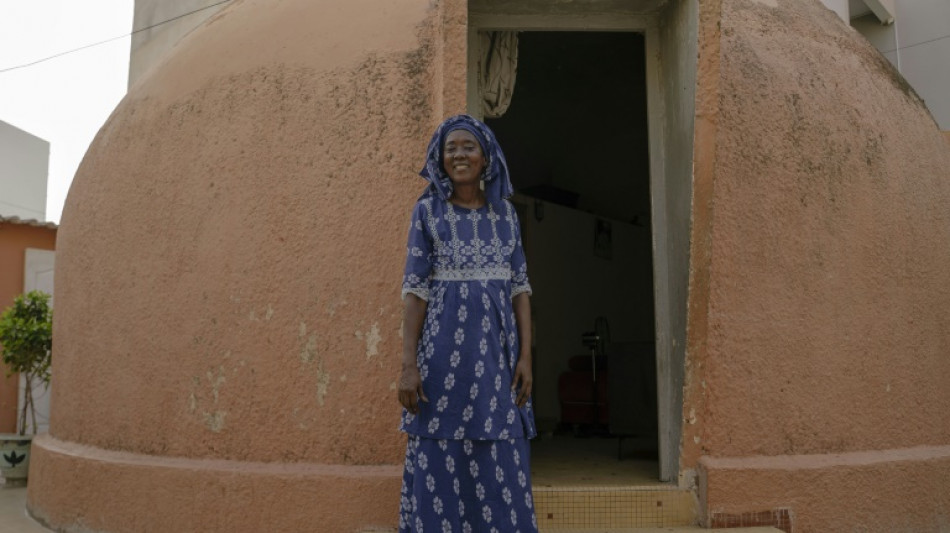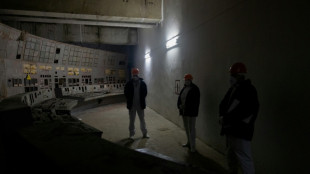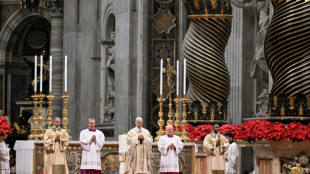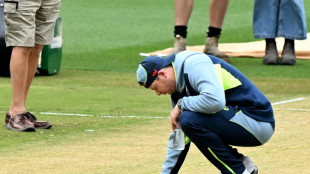
-
 Seoul to ease access to North Korean newspaper
Seoul to ease access to North Korean newspaper
-
History-maker Tongue wants more of the same from England attack

-
 Australia lead England by 46 after 20 wickets fall on crazy day at MCG
Australia lead England by 46 after 20 wickets fall on crazy day at MCG
-
Asia markets edge up as precious metals surge

-
 Twenty wickets fall on day one as Australia gain edge in 4th Ashes Test
Twenty wickets fall on day one as Australia gain edge in 4th Ashes Test
-
'No winner': Kosovo snap poll unlikely to end damaging deadlock

-
 Culture being strangled by Kosovo's political crisis
Culture being strangled by Kosovo's political crisis
-
Main contenders in Kosovo's snap election

-
 Australia all out for 152 as England take charge of 4th Ashes Test
Australia all out for 152 as England take charge of 4th Ashes Test
-
Boys recount 'torment' at hands of armed rebels in DR Congo

-
 Inside Chernobyl, Ukraine scrambles to repair radiation shield
Inside Chernobyl, Ukraine scrambles to repair radiation shield
-
Bondi victims honoured as Sydney-Hobart race sets sail

-
 North Korea's Kim orders factories to make more missiles in 2026
North Korea's Kim orders factories to make more missiles in 2026
-
Palladino's Atalanta on the up as Serie A leaders Inter visit

-
 Hooked on the claw: how crane games conquered Japan's arcades
Hooked on the claw: how crane games conquered Japan's arcades
-
Shanghai's elderly waltz back to the past at lunchtime dance halls

-
 Japan govt approves record 122 trillion yen budget
Japan govt approves record 122 trillion yen budget
-
US launches Christmas Day strikes on IS targets in Nigeria

-
 Australia reeling on 72-4 at lunch as England strike in 4th Ashes Test
Australia reeling on 72-4 at lunch as England strike in 4th Ashes Test
-
Too hot to handle? Searing heat looming over 2026 World Cup

-
 Packers clinch NFL playoff spot as Lions lose to Vikings
Packers clinch NFL playoff spot as Lions lose to Vikings
-
Guinea's presidential candidates hold final rallies before Sunday's vote

-
 BondwithPet Expands B2B Offering with Custom Pet Memorial Product
BondwithPet Expands B2B Offering with Custom Pet Memorial Product
-
Best Crypto IRA Companies (Rankings Released)

-
 Eon Prime Intelligent Alliance Office Unveils New Brand Identity and Completes Website Upgrade
Eon Prime Intelligent Alliance Office Unveils New Brand Identity and Completes Website Upgrade
-
Villa face Chelsea test as Premier League title race heats up

-
 Spurs extend domination of NBA-best Thunder
Spurs extend domination of NBA-best Thunder
-
Malaysia's Najib to face verdict in mega 1MDB graft trial

-
 King Charles calls for 'reconciliation' in Christmas speech
King Charles calls for 'reconciliation' in Christmas speech
-
Brazil's jailed ex-president Bolsonaro undergoes 'successful' surgery

-
 UK tech campaigner sues Trump administration over US sanctions
UK tech campaigner sues Trump administration over US sanctions
-
New Anglican leader says immigration debate dividing UK

-
 Russia says made 'proposal' to France over jailed researcher
Russia says made 'proposal' to France over jailed researcher
-
Bangladesh PM hopeful Rahman returns from exile ahead of polls

-
 Police suspect suicide bomber behind Nigeria's deadly mosque blast
Police suspect suicide bomber behind Nigeria's deadly mosque blast
-
AFCON organisers allowing fans in for free to fill empty stands: source

-
 Mali coach Saintfiet hits out at European clubs, FIFA over AFCON changes
Mali coach Saintfiet hits out at European clubs, FIFA over AFCON changes
-
Last Christians gather in ruins of Turkey's quake-hit Antakya

-
 Pope Leo condemns 'open wounds' of war in first Christmas homily
Pope Leo condemns 'open wounds' of war in first Christmas homily
-
Mogadishu votes in first local elections in decades under tight security

-
 'Starting anew': Indonesians in disaster-struck Sumatra hold Christmas mass
'Starting anew': Indonesians in disaster-struck Sumatra hold Christmas mass
-
Cambodian PM's wife attends funerals of soldiers killed in Thai border clashes

-
 Prime minister hopeful Tarique Rahman arrives in Bangladesh: party
Prime minister hopeful Tarique Rahman arrives in Bangladesh: party
-
Pacific archipelago Palau agrees to take migrants from US

-
 Pope Leo expected to call for peace during first Christmas blessing
Pope Leo expected to call for peace during first Christmas blessing
-
Australia opts for all-pace attack in fourth Ashes Test

-
 'We hold onto one another and keep fighting,' says wife of jailed Istanbul mayor
'We hold onto one another and keep fighting,' says wife of jailed Istanbul mayor
-
North Korea's Kim visits nuclear subs as Putin hails 'invincible' bond

-
 Trump takes Christmas Eve shot at 'radical left scum'
Trump takes Christmas Eve shot at 'radical left scum'
-
3 Factors That Affect the Cost of Dentures in San Antonio, TX


In Senegal, the last of Dakar's 'bubble homes' at risk
Marieme Ndiaye emerged from her igloo-shaped home in Senegal's capital, its 1950s space-age aesthetic in sharp contrast with the boxy, multi-storey apartments being built nearby.
The little concrete house is a head-turner, seemingly better suited for a sci-fi movie than the average Dakar residential block where it is located.
In the 1950s, around 1,200 of the tidy little homes were built in several neighbourhoods across Dakar to alleviate a post-World War II housing crunch.
The dwellings were made by inflating a giant balloon and spraying it with a concrete solution called gunite, before then deflating the balloon.
Row after row of the light-coloured domes, which could be constructed in just 48 hours, quickly sprung from the brown Sahelian landscape.
Designed by a California architect; implemented by French colonial authorities; lived in by Senegalese -- the dwellings saw only lukewarm success.
Senegal's traditionally non-nuclear, multi-generational families began outgrowing the homes' small, circular confines quickly.
In addition, the land beneath them soon became more valuable than the odd little bubbles themselves.
These days, only around 100 are estimated to remain, according to Dakar architect Carole Diop, with the majority having fallen victim to rampant urban development.
"When I was little, we only had balloons," Ndiaye said, referring to the area where she grew up and lives today in Dakar's central Zone B neighbourhood.
Without historical societies or architectural organisations campaigning to preserve the homes, the remaining residents have become the little igloos' principal protectors.
"Now we're in the middle of destroying the balloons, of transforming," Ndiaye told AFP.
"For me, it's sentimental," said the 65-year-old retiree, who is the reason her dome house is still standing. "My younger brothers want to tear down the ballon and build," she said.
The balloon homes are being preserved by residents for a variety of reasons, Diop told AFP.
But "unfortunately, many families who had the means ended up demolishing the balloon to build a building", she added.
- 'Very atypical' -
Many of those remaining have been transformed to better fit Senegalese life and no longer exist as solitary bubbles.
With an average diameter of just six metres (20 feet), a standard bubble house like Ndiaye's would have consisted of a bedroom, living room and bathroom, according to Diop.
"Many families adapted and found ways to meet the need for expansion", such as building an attachment, she said.
Ndiaye's house, first bought by her father in the 1950s, is now enveloped inside her family's larger compound, where she lives with about half a dozen relatives spanning multiple generations.
The bubble house is in the middle of a square courtyard, with other rooms along the courtyard walls.
While the bubble homes can become warm in the direct sun, even with a vent on top, Ndiaye said hers was comfortable.
A 10-minute walk away, Sekouna Yansane recently built a large house next to the bubble home his father bought in the 1950s, incorporating it as a room jutting off one side.
Describing himself as artistic, he was loath to allow the little dome to fall into developers' hands.
"It's very atypical, I love it," the 65-year-old said. "It reminds me of when I went to Mongolia, the yurts."
Four years ago he began constructing the larger home, while his next-door neighbours tore their bubble house down.
Along the street, a towering and decidedly non-descript apartment building looms where bubble houses no doubt once stood.
"Why destroy them? They are things we should keep," Yansane said, adding that a good house always has "character".
- In 100 years -
American architect Wallace Neff, who invented the bubble house, was best known for his Spanish colonial revival homes and residences for major Hollywood stars like Judy Garland and Groucho Marx.
Yet, he believed the bubble homes, which were constructed in several countries, were his most significant contribution to architecture.
Asked whether she thought the homes would still exist in 100 years, Diop voiced doubts.
"At the pace at which the city is densifying and evolving, I think unfortunately in 100 years there will be no more ballons," she said, but expressed hope that if classified or transformed for preservation, some might survive.
Yansane was slightly more positive.
"I'm in favour of preserving things," he said, adding: "In 100 years, this house, if it still exists, it's going to be something extraordinary."
A.Jones--AMWN

